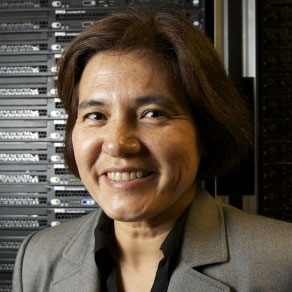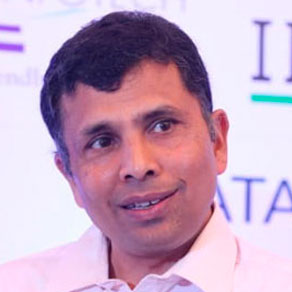
Walid Saad
[intermediate/advanced] Machine Learning for Wireless Communications: Challenges and Opportunities
Summary
Next-generation wireless networks must support ultra-reliable, low-latency communication and intelligently manage a massive number of Internet of Things (IoT) devices in real-time, within a highly dynamic environment. This need for stringent communication quality-of-service (QoS) requirements as well as mobile edge and core intelligence can only be realized by integrating fundamental notions of artificial intelligence (AI) and machine learning across the wireless infrastructure and end-user devices. AI is expected to play several roles in the next-generation of wireless networks. First, the most natural application of AI and machine learning is to exploit big data analytics to enhance situational awareness and overall network operation. In this context, AI will provide the wireless network with the ability to parse through massive amounts of data, generated from multiple sources that range from wireless channel measurements and sensor readings to drones and surveillance images, in order to create a comprehensive operational map of the massive number of devices within the network. This map can, in turn, be exploited to optimize various functions, such as fault monitoring and user tracking, across the wireless network. Second, beyond its powerful prediction and data analytics functions, AI will be a major driver of intelligent and data-driven wireless network optimization. For instance, reinforcement learning tools will enable the introduction of intelligent resource management tools, that can be used to address a variety of problems ranging from cell association and radio access technology selection to frequency allocation, spectrum management, power control, and intelligent beamforming. In contrast to conventional distributed optimization technique, that are often done iteratively in an offline or semi-offline manner. AI-guided resource management mechanisms will be able to operate in a fully online manner by learning and predicting, in real time, the states of the wireless environment and the network’s users, thus allowing the network to adapt to those predictions. Third, the rapid deployment of highly user-centric wireless services, such as virtual reality strongly motivates the need for wireless networks that can track and adapt to their human user behavior. In this regard, machine learning is perhaps the only tool that is capable to learn and mimic human behavior. Last, but not least, distributed machine learning techniques, such as federated learning, will play an instrumental role in future wireless networks. On the one hand, they can be used to enhance wireless network design. On the other hand, deploying federated learning over wireless networks requires a careful design of both learning and networking functions. Given this prominent role that AI and machine learning will play in tomorrow’s wireless networks, it is imperative to provide an in-depth overview on their fundamentals as well as their applications in wireless and communication networks.
To this end, the goal of this tutorial is to provide one of the first holistic tutorials on the topic of machine learning for wireless network design. In particular, we first provide a comprehensive treatment of the fundamentals of machine learning and artificial neural networks, which are one of the most important pillars of machine learning. After providing a substantial introduction to the basics of machine learning, we introduce a classification of the various types of neural networks that include feed-forward neural networks, recurrent neural networks, spiking neural networks, and deep neural networks. For each type, we provide an introduction on their basic components, their training processes, and their use cases with specific example neural networks. Then, we overview a broad range of wireless applications that can make use of neural network designs. This range of applications includes spectrum management, multiple radio access technology cellular networks, wireless virtual reality, mobile edge computing and caching, drone-based communications, the Internet of Things, and vehicular networks. For each application, we first outline the main rationale for applying machine learning while pinpointing illustrative scenarios. Then, we overview the challenges and opportunities brought forward by the use of neural networks in the specific wireless application. We complement this overview with a detailed example drawn from the state-of-the-art. We then turn our attention to the interplay between distributed learning (e.g., federated learning) and wireless networks. We explain the basics of distributed learning and then discuss how it will be deployed over wireless networks. Finally, we conclude by shedding light on the potential future works within each specific area and within the overall area of AI for wireless networks.
Syllabus
Introduction to Machine Learning:
- What is machine learning?
- Machine learning and artificial intelligence.
- Brief overview on the basics of machine learning.
Artificial Neural Networks (ANNs) Preliminaries:
- Brief introduction to machine learning and motivation behind artificial neural networks.
- Introduction to the architecture of artificial neural networks and their training process.
Classification of Artificial Neural Networks:
- Introduction to recurrent neural networks: fundamentals, training, and specific examples such as echo state networks.
- Introduction to spiking neural networks: fundamentals, training, and specific examples such as liquid-state machines.
- Introduction to deep neural networks: fundamentals, training, and specific examples such as long short term memory and convolutional neural networks.
- Brief review of other types of artificial neural networks.
Reinforcement Learning:
- Introduction to reinforcement learning.
- Q-learning: basics and state of the art.
- Boltzmann-Gibbs learning: basics and state of the art.
- Reinforcement learning with artificial neural networks.
- Deep reinforcement learning: basics and state of the art.
AI for Virtual Reality (VR) over Wireless Networks:
- Brief introduction to VR and explanation on the role of VR over wireless in future networks.
- Overview of the applications for reinforcement learning and artificial neural networks in wireless VR.
- Step-by-step explanation of an example application that uses recursive neural networks for wireless VR.
- Future works and opportunities for ANNs in the wireless VR application domain.
AI for Wireless Communications using Drones:
- Overview on the role of drones in wireless communications and networking.
- Overview on potential applications of AI for drone-based communications.
- Step-by-step overview on a sample application that uses recurrent and spiking neural networks for optimizing the performance of drone-based wireless communications.
- Step-by-step overview on an illustrative application that uses deep reinforcement learning for path planning in cellular-connected drone networks.
- Future works and opportunities for optimizing drone communications using machine learning.
AI for Ultra Reliable Low Latency Communications (URLLC):
- Brief overview on URLLC and the need for AI.
- Overview on potential applications of reinforcement learning for URLLC.
- Step-by-step introduction to an example application using deep learning for model-free URLLC.
- Future works and opportunities of ANNs in the URLLC application domain.
Distributed learning over wireless networks:
- What is distributed learning? why is it different than classical machine learning?
- Principles of distributed and federated learning.
- Synergies between federated learning and wireless networks.
- Federated learning over wireless networks: Case study.
- Federated learning for wireless networks: Case study.
Conclusions and future directions:
- Brief overview on other applications of AI and machine learning, such as smart cities.
- Discussion of future directions and open opportunities: toward AI-inspired wireless networks.
- Conclusions and summary.
References
- Chen, U. Challita, W. Saad, C. Yin, and M. Debbah, “Artificial Neural Networks-Based Machine Learning for Wireless Networks: A Tutorial”, IEEE Communications Surveys and Tutorials, vol. 21, no. 4, pp. 3039-3071, Fourth quarter 2019.
- Chen, W. Saad, and C. Yin, “Virtual Reality over Wireless Networks: Quality-of-Service Model and Learning-Based Resource Management”, IEEE Transactions on Communications, vol. 66, no. 11, pp. 5621 – 5635, November 2018.
- Chen, Z. Yang, W. Saad, C. Yin, H. V. Poor, and S. Cui, “A Joint Learning and Communications Framework for Federated Learning over Wireless Networks”, IEEE Transactions on Wireless Communications, vol. 20, no. 1, pp. 269 – 283, January 2021.
- Challita, W. Saad, and C. Bettstetter, “Interference Management for Cellular-Connected UAVs: A Deep Reinforcement Learning Approach”, IEEE Transactions on Wireless Communications, vol. 18, no.4, pp. 2125-2140, April 2019.
- Bacci, S. Lasaulce, W. Saad, and L. Sanguinetti, “Game Theory for Networks: A tutorial on game-theoretic tools for emerging signal processing applications,” IEEE Signal Processing Magazine, vol. 33, no. 1, pp. 94-119, January 2016.
Pre-requisites
General familiarity with wireless networks and communications will be useful to understand some of the application-driven concepts. The learning/AI aspect does not have pre-requisites since it will be covered at a basic level.
Short bio
Walid Saad (S’07, M’10, SM’15, F’19) received his Ph.D degree from the University of Oslo in 2010. He is currently a Professor at the Department of Electrical and Computer Engineering at Virginia Tech, where he leads the Network sciEnce, Wireless, and Security (NEWS) laboratory. His research interests include wireless networks, machine learning, game theory, security, unmanned aerial vehicles, cyber-physical systems, and network science. Dr. Saad is a Fellow of the IEEE. He is also the recipient of the NSF CAREER award in 2013 and the Young Investigator Award from the Office of Naval Research (ONR) in 2015. He was the author/co-author of ten conference best paper awards at WiOpt in 2009, ICIMP in 2010, IEEE WCNC in 2012, IEEE PIMRC in 2015, IEEE SmartGridComm in 2015, EuCNC in 2017, IEEE GLOBECOM in 2018, IFIP NTMS in 2019, IEEE ICC in 2020, and IEEE GLOBECOM in 2020. He is the recipient of the 2015 Fred W. Ellersick Prize from the IEEE Communications Society, of the 2017 IEEE ComSoc Best Young Professional in Academia award, of the 2018 IEEE ComSoc Radio Communications Committee Early Achievement Award, and of the 2019 IEEE ComSoc Communication Theory Technical Committee. He was also a co-author of the 2019 IEEE Communications Society Young Author Best Paper and of the 2021 IEEE Communications Society Young Author Best Paper.
























